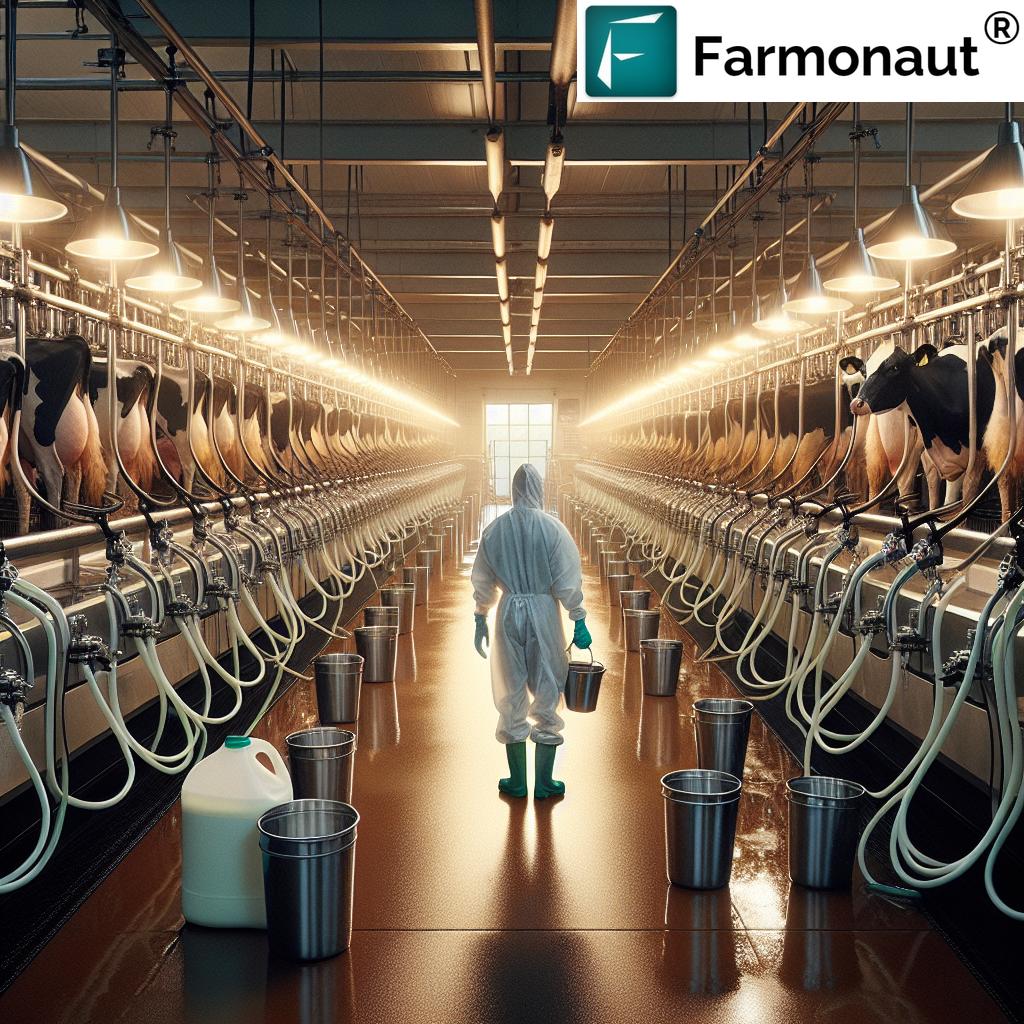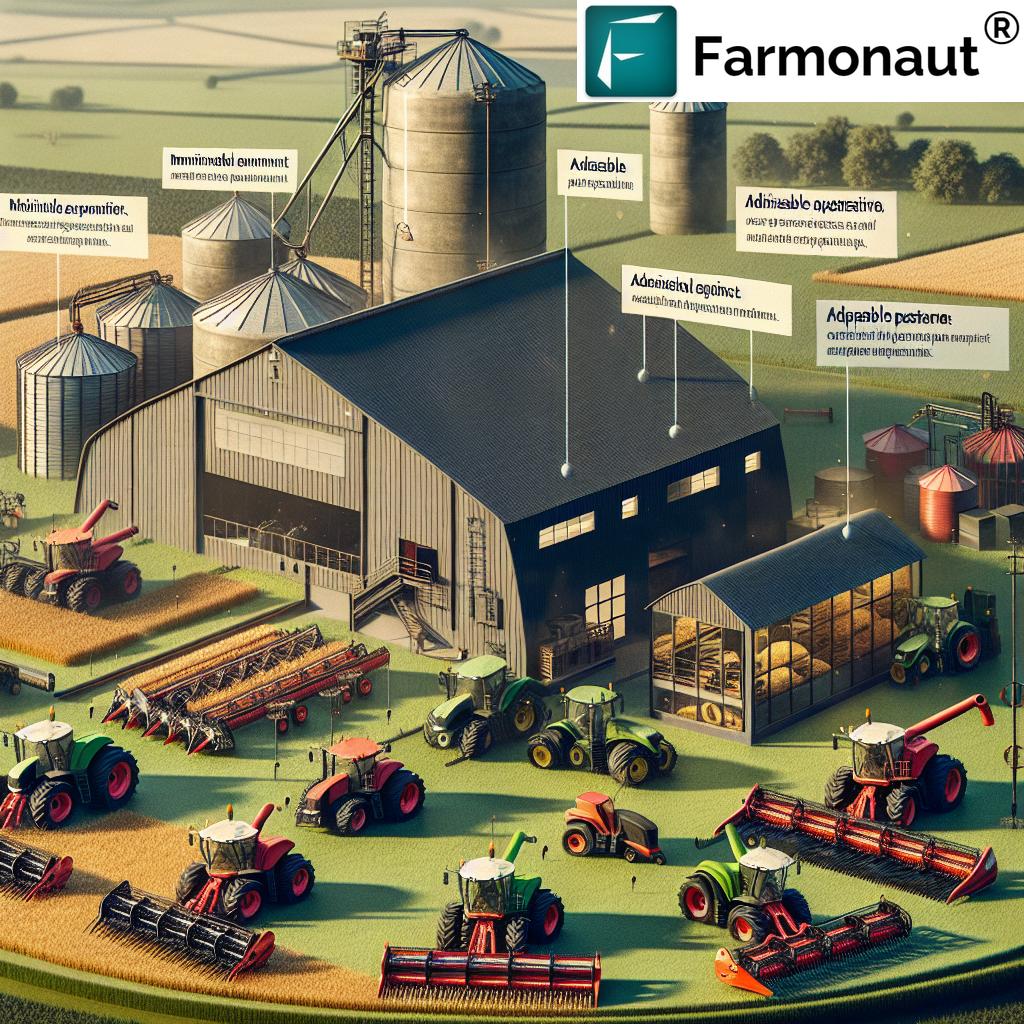Table of Contents
- Introduction: Dairy Farming Hygiene & Milk Quality
- Dairy Hygiene Trivia
- Comparison Table: 10 Essential Dairy Hygiene Tips
- 1. Personal Hygiene of Milkers
- 2. Cow Hygiene – Bathing, Hoof & Tail Care
- 3. Milking Equipment Sanitation
- 4. Dairy Environment Hygiene
- 5. Milk Storage and Handling
- 6. Manure Management in Dairy Farming
- 7. Foot Care for Dairy Cows
- 8. Disease Prevention in Dairy Cows
- 9. Sustainable Cleaning in Dairy Farming
- 10. Record Keeping & Compliance
- Farmonaut’s Role in Sustainable Dairy Farm Hygiene
- FAQ on Dairy Hygiene & Milk Quality
- Conclusion: Achieving Sustainable Milk Quality Improvement
Dairy Farming Hygiene: 10 Tips to Boost Milk Quality
Dairy farm hygiene is the foundation of sustainable, high-quality milk production. It not only enhances the quality of milk produced but also ensures disease prevention in dairy cows, boosts animal welfare in dairy farming, and safeguards the broader environment. With rising consumer focus on food safety and environmental sustainability, implementing comprehensive hygiene practices is no longer optional—it’s essential.
In this guide, we distill the most effective, science-backed hygiene practices for dairy farmers—covering everything from milker personal hygiene to adopting eco-friendly cleaning solutions. Whether you operate a small homestead or run a large commercial herd, these tips empower you to optimize milk quality, improve animal health, and reduce environmental impact.
“Up to 90% of milk contamination is linked to poor hygiene during milking and equipment cleaning.”
Comparison Table: Impact of 10 Essential Dairy Hygiene Practices
| Hygiene Practice | Estimated Impact on Milk Quality (% Improvement) | Disease Risk Reduction (Estimated %) | Sustainability Benefit | Easy-to-Implement Action |
|---|---|---|---|---|
| Personal Hygiene of Milkers | Up to 12% | 20–25% | Reduces water & chemical use by targeted, routine cleaning | Hand washing, gloves, clean uniforms |
| Cow Cleanliness (Bathing, Hoof & Tail Care) | 6–10% | 18–22% | Lower pathogen load, reduced antibiotic need | Regular washing, hoof trimming, tail clipping |
| Milking Equipment Sanitation | 15–20% | 30–40% | Hot water-based routine saves detergents | Daily hot water cleaning, rubber replaced regularly |
| Dairy Environment Hygiene | 8–11% | 20–23% | Improves bedding reuse, promotes composting | Good drainage, daily manure removal |
| Milk Storage & Handling | 13–16% | 28% | Reduced spoilage—less waste | Cool milk below 4°C immediately |
| Manure Management | 5–8% | 22–27% | Fertilizer reuse via composting | Regular removal, compost manure |
| Foot Care for Dairy Cows | 3–6% | 14–18% | Fewer hoof treatments, less antibiotic use | Routine trimming, footbaths |
| Disease Management & Prevention | 7–10% | 40–65% | Less medication, mitigates outbreaks | Isolate sick cows, maintain health logs |
| Sustainable Cleaning Practices | 6–9% | 20–27% | 25–50% water reduction, less chemical runoff | Switch to steam cleaning & natural disinfectants |
| Record Keeping & Compliance | 4–8% | 10–16% | Early detection avoids costly outbreaks/waste | Digital logs, routine audits |
Looking for automated data-driven insights? Our API lets you bring satellite-backed farm management directly into your workflow. Developer Documentation is available for integration!
1. Personal Hygiene of Milkers: The Frontline of Dairy Farm Hygiene
Personal hygiene for milkers is the first line of defense in preventing milk contamination. Hands are a primary vector for transferring pathogens from the barn environment to the udder and ultimately into the milk itself.
- Wash and sanitize hands thoroughly before and after each milking session. Use an approved disinfectant.
- Wear clean protective clothing, gloves, face masks, boots, and overalls. This reduces the risk of disease transmission and physical contaminants.
- Avoid smoking, eating, or drinking in the milking pool or barn areas to minimize risk of unintended contamination.
- After milking, wash hands and dip in disinfectant to kill any bacteria picked up during the process.
- Design a clear workflow to ensure clean zones around each milking area — marked pathways, separate entry for staff, and regular audits are best practice.
Implementing robust personal hygiene standards for milkers not only improves milk quality but is critical to disease prevention in dairy cows and effective sanitation practices for dairy farms.
2. Cow Hygiene: Regular Bathing, Hoof & Tail Care for Milk Quality Improvement
Cow cleanliness is vital. Proper hygiene for each animal sets the tone for the entire dairy environment and dramatically impacts both milk quality and animal welfare in dairy farming.
- Regular bathing removes dirt, manure, and loose hair—key sources of contamination and skin infections.
- Daily hoof cleaning and routine hoof trimming help prevent lameness and disease. This is a cornerstone of foot care for dairy cows.
- Tails should be clipped or trimmed regularly to avoid fecal matter contaminating udders and milk during milking.
- Focus on udder cleanliness: Use a separate towel for each animal to reduce cross-contamination and enhance cleanliness.
Hygiene at the cow level is not only vital for preventing milk contamination but also forms the basis for sustainable cleaning in dairy farming, as it can reduce reliance on chemical disinfectants downstream.
3. Milking Equipment Sanitation: Clean Milking Equipment, Healthier Milk
Properly cleaning and sanitizing milking equipment is non-negotiable for milk quality improvement. Equipment represents a major risk if poorly maintained, harboring pathogens that can rapidly multiply in residual milk.
- Establish a routine cleaning schedule: Immediately after each use, wash all equipment with hot water (ideally above 60°C) and dairy-approved detergents.
- Sanitize using approved chemical agents. Chlorine, peracetic acid, and iodine-based products are popular when used as directed and rinsed thoroughly.
- Replace rubber components (liners, hoses, clusters) every 2,500 milkings to avoid micro-crack buildup—a major source of bacterial contamination.
- Air-dry equipment to minimize microbial survival, never towel-dry reusable parts.
Remember: Clean milking equipment underpins both hygiene standards and sustainability, enabling less chemical and water consumption over the lifetime of your equipment.
4. Dairy Environment Hygiene: Designing Clean, Healthy Barns & Areas
The dairy environment—barns, milking parlors, and loose bedding areas—should support cow health, welfare, and milk quality improvement.
- Infrastructure: Ensure good drainage and proper ventilation in barns to prevent dampness and pathogen growth.
- Adequately space animals to reduce stress and disease transmission.
- Maintain loose bedding (straw, sawdust) in a hygienic state—replace and fluff regularly. Contaminated bedding can be a persistent source of bacteria.
- Regular removal of manure and waste prevents pathogen buildup and maintains a cleaner, drier environment for cows to rest.
Sustainable environmental hygiene not only provides immediate disease prevention but is essential for long-term sustainability by improving cow comfort and milk production efficiency.
“Sustainable hygiene practices can reduce dairy farm disease outbreaks by over 60%, improving both animal health and milk quality.”
5. Milk Storage and Handling: Preventing Milk Contamination After Milking
Proper milk storage and handling post-milking is essential for **preventing milk contamination** and ensuring that every drop delivered is of premium quality.
- Rapidly cool milk to below 4°C (or 39°F) immediately to inhibit bacterial growth.
- Use only sanitized, covered containers for transport and storage.
- Keep the milk storage room segregated from cleaning and wash-up areas to reduce contamination risk.
- Monitor temperature and cleanliness regularly: data loggers, simple thermometers, and scheduled inspections all help.
By adopting high-standard milk storage and handling processes, farmers can greatly enhance milk quality, shelf-life, and compliance with food safety regulations.
6. Manure Management in Dairy Farming: Sustainably Reducing Pathogen Levels
Effective manure management in dairy farming is not only about maintaining cleanliness — it’s key for reducing disease risk and promoting environmental sustainability.
- Remove manure frequently—preferably daily—from barns and alleyways to reduce pathogen buildup and fly populations.
- Use proper composting methods to treat manure. Composting reduces pathogens and creates nutrient-rich, sustainable fertilizer.
- Beware of runoff: Store compost piles on impermeable surfaces and design containment to avoid water contamination, protecting local water sources.
- Integrate manure as fertilizer for crops—this closes nutrient cycles and further supports sustainable dairy farm hygiene.
Good manure management not only adheres to sanitation practices for dairy farms but directly supports the sustainable future of your farming operation.
7. Foot Care for Dairy Cows: Hoof Trimming & Disease Prevention
Lameness and hoof diseases can silently undermine both milk quality and animal welfare. Diligent foot care for dairy cows is a vital aspect of dairy farm hygiene.
- Routine hoof trimming—at least twice a year—ensures good posture and reduces the risk of foot diseases.
- Use disinfectant footbaths regularly to control and prevent infections like digital dermatitis.
- Provide written protocols for foot care and train staff to notice subtle lameness early.
- Observe cow movements daily: Any change in gait can signal emerging hoof problems.
Preventing lameness dramatically enhances both milk quality improvement and cow longevity, fulfilling both economic and ethical duties of dairy farm management.
8. Disease Prevention in Dairy Cows: Isolation, Monitoring & Biosecurity
Disease prevention in dairy cows—including mastitis, lameness, and infectious viral or bacterial diseases—depends on vigilant management and record-keeping.
- Isolate sick animals immediately to prevent disease transmission.
- Keep detailed records of treatments, vaccinations, and symptoms. Digital tools and management apps are excellent for this purpose.
- Label milk from sick cows as unsuitable for sale or human consumption to comply with food safety regulations.
- Implement biosecurity protocols—control rodents, insects, birds, and human traffic within and between barns to reduce disease spread.
- Train staff to recognize early signs and respond swiftly to prevent an outbreak.
Disease management is not only animal-welfare oriented but also supports sustainability through reduced reliance on antibiotics and lower environmental impact.
Discover how Farmonaut’s Carbon Footprinting can help track and reduce your dairy farm’s environmental impact through real-time emissions monitoring.
Enhance supply chain transparency and compliance with Farmonaut’s Blockchain Traceability Solution—perfect for meeting stringent food safety regulations in dairy production.
Cut fraud and streamline your agricultural finances using Farmonaut’s Crop Loan & Insurance Services, which leverages satellite data for secure dairy farm verification.
9. Sustainable Cleaning in Dairy Farming: Eco-Friendly Sanitation Practices
Sustainable cleaning in dairy farming means reducing environmental impact while maintaining impeccable dairy farm hygiene. The key is to adopt smart, eco-friendly technologies:
- High-temperature steam cleaning sanitizes equipment and surfaces effectively, reduces chemical and water use.
- Electrolyzed water systems: Produce a powerful disinfectant on-site with minimal inputs—safe for both animals and humans.
- Plant-based, biodegradable disinfectants: Lower risk to workers, animals, and soils while degrading rapidly in the environment.
- Routine cleaning schedules: Prevent grime and biofilm buildup, making cleaning tasks easier and limiting chemical dependence.
Tip: Track cleaning schedules and water usage digitally to identify efficiency gains over time. Sustainability is all about monitoring, adjusting, and improving.
10. Record Keeping & Compliance: The Backbone of Dairy Farm Hygiene
Maintaining detailed records of all hygiene practices, equipment cleaning, treatments, inspections, and disease events is fundamental for regulatory compliance and continuous improvement.
- Document each hygiene procedure: Logging disinfection dates, staff responsible, and products used enables trend tracking.
- Maintain digital logs for treatments, inspections, and disease outbreaks. This enables faster recalls and regulatory reporting.
- Schedule regular audits to assess compliance and effectiveness of current practices—empowering ongoing improvement.
- Train staff on record-keeping procedures, building a culture of transparency and continuous learning.
Comprehensive record keeping brings peace of mind—not just ticking audit boxes but proving your commitment to quality, sustainability, animal welfare, and regulatory adherence.
Farmonaut’s Role in Sustainable Dairy Farm Hygiene & Management
As a global leader in precision agriculture, Farmonaut offers advanced farm management tools that can benefit the modern dairy operation in several critical ways:
- Satellite-powered farm monitoring enables you to oversee vast herds and multiple barns remotely, ensuring environmental cleanliness and animal welfare at scale.
- With real-time Large-Scale Farm Management via our digital App, tracking hygiene, cleaning schedules, and herd health is streamlined—all in one place.
- Jeevn AI Advisory System offers personalized guidance on optimal milking times, weather patterns, and herd movement—boosting milk quality and minimizing animal stress.
- Fleet & Resource Management Tools ensure that manure removal and cleaning teams are optimally routed, saving fuel and reducing operational costs. See more: Fleet Management Solutions.
- Record keeping is automated and transparent, simplifying compliance and sustainability reporting at all scales.
- Our resource management and carbon footprinting tools help you improve water efficiency; our real-time monitoring avoids over-irrigation and excessive cleaning water wastage.
- Blockchain-based traceability ensures every liter of milk has a verified journey—from cow to consumer—strengthening your dairy’s reputation for quality and safety.
At Farmonaut, we are committed to empowering dairy farmers worldwide by enabling robust hygiene management, sustainable operations, and transparent, high-quality production.
Frequently Asked Questions: Dairy Hygiene & Milk Quality
Why is hygiene so important in dairy farming?
Hygiene in dairy farming is crucial for milk quality improvement, disease prevention in dairy cows, and animal welfare. Poor hygiene can lead to contamination, lower milk yields, increased disease outbreaks, and ultimately financial losses for the farm.
What is the fastest way to improve milk quality on a dairy farm?
Improving personal hygiene of milkers, routine cleaning and sanitation of milking equipment, and rapid cooling and proper storage of milk are among the fastest, most effective steps to boost milk quality and reduce contamination risks.
How often should milking equipment be sanitized?
All milking equipment should be cleaned and sanitized after every use. Rubber components should be replaced after every 2,500 milkings to minimize wear and the risk of bacterial buildup.
Can sustainable cleaning solutions really reduce costs?
Yes. Sustainable solutions like high-temperature steam or electrolyzed water reduce the need for chemicals and minimize water use over time, resulting in lower ongoing costs and improved environmental outcomes.
How does record keeping help with dairy farm hygiene?
Detailed records ensure all hygiene protocols are followed, enable early detection of trends (like disease outbreaks), boost regulatory compliance, and support efficient auditing processes.
How can Farmonaut help in dairy farming?
We provide advanced digital tools for remote crop and livestock monitoring, cleaning schedules, environmental impact tracking, blockchain traceability, and actionable AI-driven advice—empowering farmers to maintain the highest hygiene and sustainability standards in dairy operations, efficiently and affordably.
Conclusion: Building a Future-Proof, Sustainable Dairy Operation
Dairy farming hygiene stands at the core of milk quality improvement, animal health, and sustainable food production. By implementing these proven practices—from rigorous milker hygiene to innovative cleaning solutions and digital farm management—producers can protect the health of their herds, achieve premium milk standards, and contribute to a greener planet.
Ready to take your dairy hygiene and sustainability practices to the next level? Explore our digital management tools, API, and mobile apps, and tap into real-time, satellite-powered data for integrated farming success.
Implement comprehensive dairy farm hygiene today to ensure your milk remains pure, your cows stay healthy, your environment is protected, and your operation thrives sustainably for generations to come.

















